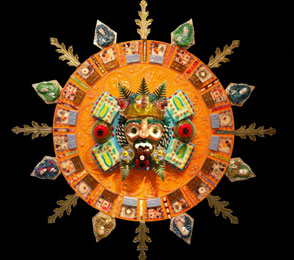
He recorded these predictions in a book of poetic verses, Les Prophéties, in 1955.

It is through this perceived illumination that Nostradamus gained insight for his predictions about momentous future events. He would gaze upon this water until he perceived 'a slight flame out of the emptiness'. Erika Cheetham describes Nostradamus' technique of placing a brass bowl of water upon a tripod in her book, The Prophecies of Nostradamus (1973). Nostradamus used a scrying method familiar to ancient Greece a scrying bowl filled with water. Nevertheless, it was the infamous French prophet, Michel de Nostredame, more commonly known as Nostradamus (1503-1566), who first put scrying on the map. The first recorded examples of scrying appear in China in around 3000 BCE, in Egypt in 2500 BCE, and in Greece in 2000 BCE. It has long been used as a lens into past, present and future. Yet scrying can reveal so much more than 'the fairest of them all'. However, AI researchers have been turning up some surprising results - results which suggest there is more to this story than Marcus and Chiang allow for.Scrying rose to popular fame thanks to none other than Disney. The Queen in Snow White's famous line, 'Magic mirror on the wall.' is, for many, our first introduction to the age-old divination practice of scrying. If this technology is just a mindless copyist, it may prove tremendously useful but it’s not going to be taking over the world anytime soon. Marcus and Chiang make a good case for scepticism and I found it somewhat comforting. “It’s just auto complete,” says Marcus, “and auto complete gives you bullshit.” The science fiction writer Ted Chiang calls ChatGPT “a blurry JPEG of the web.” That’s why its essays are boilerplate or error-ridden or both it has no concept of truth or falsity. Given a bit of information, it guesses what comes next, based on its vast corpus of training data. It doesn’t distill general principles from examples in the way that humans do it just matches patterns. Marcus argues that AI in its current form is merely simulating the ability to reason. Back then, I was leaning towards the Gary Marcus view. I feel differently about AI than I did even a month ago, when I last wrote about it. To summon them, to commune with them, might bring great insight and rich rewards but it was also fraught with danger. The spirits had agency of their own and they were unpredictable, capricious, judgemental. Magic was not, however, a benign, user-friendly service, always ready to do our bidding. In the world of sixteenth century England, magic was woven into everyday life like digital technology is now. But recent developments in AI have got me thinking about Clarke’s aphorism in another way. I touch a screen and an image of my friend appears, and I can talk to her. We usually take that to refer to the way tech can perform frictionless everyday miracles. Clarke, “any sufficiently advanced technology is indistinguishable from magic”. It was a strange world back then, and the world is getting strange again.


Dee practiced purifying religious rituals to ensure he only conjured good spirits rather than demons. Kelley dictated whole books of detailed prophecy, and they toured the grand houses of Europe together, holding séances. He teamed up with a rather dubious character called Edward Kelley who became his ‘scryer’ - the one who actually gazes into the ball or mirror and takes messages from spirits. He was denounced as a conjuror of devils, perhaps a devil himself.Īs his power at court declined, Dee became drawn deeper and deeper into the supernatural, which he believed could bring great benefit to mankind, although it sounds to me as if he was simply hooked on it. The magical side of his work was a source of fascination to Elizabeth but it sullied Dee’s name within and beyond the court. He used his black mirror to conjure visions, communicate with angels, and peer into the future. He was also a kind of wizard, immersed in the occult - in numerology, astrology and alchemy. He was a worldly man, who coined the phrase ‘British Empire’. Dee, who may have been the model for Prospero in The Tempest, was an influential counsellor to Queen Elizabeth and a European authority on mathematics, astronomy, navigation and cartography.


 0 kommentar(er)
0 kommentar(er)
